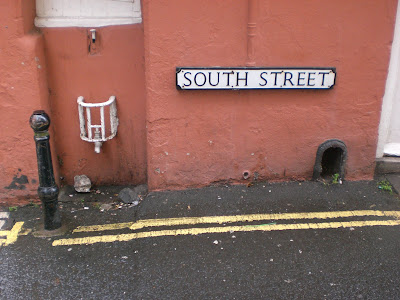I've some fond memories of Barnes, especially the Sun Inn by the pond which was my first 'regular' as a spotty youth. A pleasant walk across the Common, a drink around the pond on a warm summers evening (could only afford the one usually) and then a nice stroll back. All very bucolic and English so our spur of the moment decision to 'go somewhere' last Sunday was partly influenced by my desire tovisit old haunts and partly to see if there was anything worth noting in what was always a very village-like part of South London.
I could only fit in a brief stroll but there were a few nice items, some blue plaques and some lovely old buildings, but I had the feeling that, being a very desirable (aka expensive) part of London, Barnes had been scrubbed up nicely and a lot of the old stuff had been tidied up.
Barnes High Street
A typical butchers shop with its traditional butchers tiles and mosaics. I'm not really sure why butchers seem to be such bastions of tile work - possibly as it was easy to keep clean and tidy - but they do have some nice examples. The shop is still owned by the Seals as well...
 Barnes High Street
Barnes High StreetThere were no old ghost signs in Barnes, but it did look as though a couple of older companies had maintained some painted signage. This one was up by the river...
 Barnes High Street
Barnes High Street...whereas this was more toward the pond. It's still the site of a pharmacy but I bet that sign has been around for a while!
 The Terrace
The TerraceThis mosaic of Bacchus was by the front door of a house fronting the river. I was wondering if it was a copy of a genuine Roman mosaic, but nicely done anyway.

The Terrace
Very odd one this. A quite ornate house facing the river with two painted boards overhanging the pavement. Each board had two very worn and indistinct painted surfaces with depictions of sailing ships (you have to click on the picture below to make sense of it really). But what was the house originally?
 Barnes High Street
Barnes High StreetI like this one and pound to a penny it'll be used in a specific posting on mosaics as well! A typical shop front proudly proclaiming the original owner. Sad to report that they are no longer there...

Barnes High Street
One of the remaining sections of original tilework. OK, so it's not that special but it's loud and proud and it goes well with the black and white checker board mosaic so just marvel at its ability to survive
 Barnes High Street
Barnes High StreetLast, but by no means least. I almost missed this as I was strolling down the road. Very grey and innocuous, it's only when you look closely that you realise that it is, in fact, an early vending machine. I'm not sure what it sold but my guess would be cigarettes, but whatever it was it cost a shilling. I also presume it was a little more colourful in its youth. Anyway it's very impressive that it's managed to hang on for so long.
 What I'd be really interested to know was when the last item was purchased from it. Presumably before 'Decimal Day' in 1971!
What I'd be really interested to know was when the last item was purchased from it. Presumably before 'Decimal Day' in 1971!



















 It's a nice atmospheric shot, but there's bunting out and the bridge seems to have been turned into a triumphal archway with ivy, flags and a sign. All very intriguing and when you zoom in on the sign it gets even more interesting...
It's a nice atmospheric shot, but there's bunting out and the bridge seems to have been turned into a triumphal archway with ivy, flags and a sign. All very intriguing and when you zoom in on the sign it gets even more interesting...











